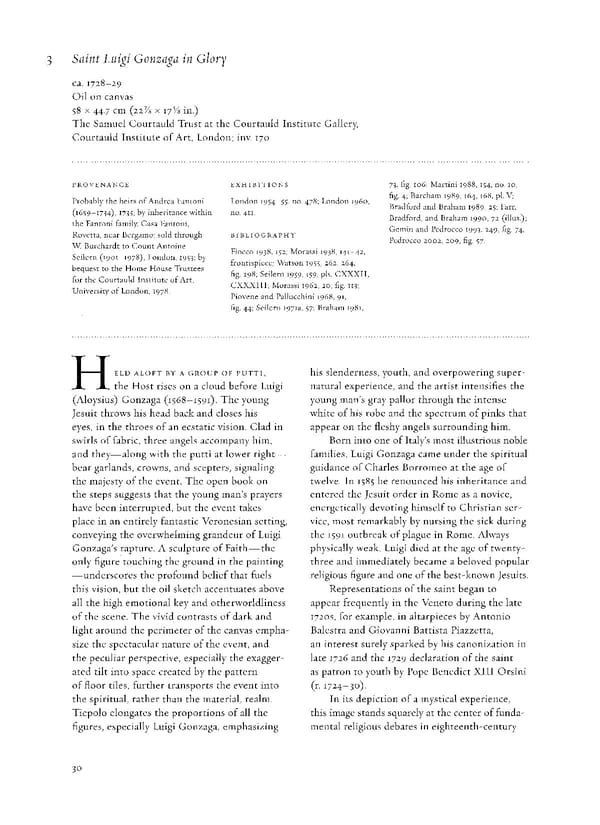3 Saint Luigi Gonzaga in Glory ca. 1728-29 Oil on canvas 5 58 x 44.7 cm (22/8 x i7 /s in.) The Samuel Courtauld Trust at the Courtauld Institute Gallery, Courtauld Institute of Art, London; inv. 170 PROVENANCE EXHIBITIONS 73, fig. 106; Martini 1988, 154, no. 10, Probably the heirs of Andrea Fantoni London 1954-55, no. 478; London 1960, fig. 4; Barcham 1989, 164, 168, pi. V; (1659-1734), 1735; by inheritance within no. 411. Bradford and Braham 1989, 25; Farr, the Fantoni family Casa Fantoni, Bradford, and Braham 1990, 72 (illus.); Gemin and Pedrocco 1993, 249, fig. 74; Rovetta, near Bergamo; sold through BIBLIOGRAPHY Pedrocco 2002, 209, fig. 57. W Burchardt to Count Antoine Fiocco 1938, 152; Morassi 1938, 141-42, Seilern (1901-1978), London, 1953; by frontispiece; Watson 1955, 262, 264, bequest to the Home House Trustees fig. 298; Seilern 1959, 159, pis. CXXXII, for the Courtauld Institute of Art, CXXXIII; Morassi 1962, 20, fig. 113; University of London, 1978. Piovene and Pallucchini 1968, 91, fig. 44; Seilern I97ia, 57; Braham 1981, HELD ALOFT BY A GROUP OF PUTTI, his slenderness, youth, and overpowering super- the Host rises on a cloud before Luigi natural experience, and the artist intensifies the (Aloysius) Gonzaga (1568-1591). The young young man's gray pallor through the intense Jesuit throws his head back and closes his white of his robe and the spectrum of pinks that eyes, in the throes of an ecstatic vision. Clad in appear on the fleshy angels surrounding him. swirls of fabric, three angels accompany him, Born into one of Italy's most illustrious noble and they—along with the putti at lower right— families, Luigi Gonzaga came under the spiritual bear garlands, crowns, and scepters, signaling guidance of Charles Borromeo at the age of the majesty of the event. The open book on twelve. In 1585 he renounced his inheritance and the steps suggests that the young man's prayers entered the Jesuit order in Rome as a novice, have been interrupted, but the event takes energetically devoting himself to Christian ser- place in an entirely fantastic Veronesian setting, vice, most remarkably by nursing the sick during conveying the overwhelming grandeur of Luigi the 1591 outbreak of plague in Rome. Always Gonzaga's rapture. A sculpture of Faith—the physically weak, Luigi died at the age of twenty- only figure touching the ground in the painting three and immediately became a beloved popular —underscores the profound belief that fuels religious figure and one of the best-known Jesuits. this vision, but the oil sketch accentuates above Representations of the saint began to all the high emotional key and otherworldliness appear frequently in the Veneto during the late of the scene. The vivid contrasts of dark and 17208, for example, in altarpieces by Antonio light around the perimeter of the canvas empha- Balestra and Giovanni Battista Piazzetta, size the spectacular nature of the event, and an interest surely sparked by his canonization in the peculiar perspective, especially the exagger- late 1726 and the 1729 declaration of the saint ated tilt into space created by the pattern as patron to youth by Pope Benedict XIII Orsini of floor tiles, further transports the event into (r. 1724-30). the spiritual, rather than the material, realm. In its depiction of a mystical experience, Tiepolo elongates the proportions of all the this image stands squarely at the center of funda- figures, especially Luigi Gonzaga, emphasizing mental religious debates in eighteenth-century 30
 Giambattista Tiepolo: Fifteen Oil Sketches Page 30 Page 32
Giambattista Tiepolo: Fifteen Oil Sketches Page 30 Page 32